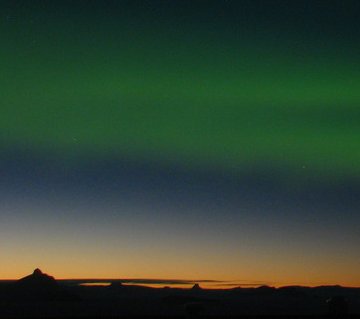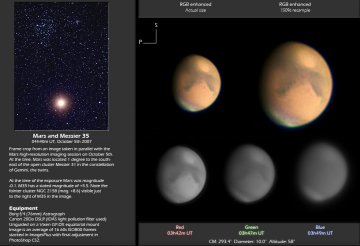 Where's Saturn? Is that a UFO--or the ISS? What's the name of that star? Get the answers from mySKY--a fun new astronomy helper from Meade. . Where's Saturn? Is that a UFO--or the ISS? What's the name of that star? Get the answers from mySKY--a fun new astronomy helper from Meade. . WEEKEND PLANETS: Venus, Saturn and the slender crescent Moon are gathering in the morning sky and they'll be beautifully close together all weekend long. Look east at dawn on Saturday and Sunday for a sight guaranteed to wake you up. Sky maps: Oct. 6, Oct. 7. Oct 5th images: from Günther Strauch of Borken, NRW, Germany; from Helmut Groell of Moers, Germany. AURORA SUNRISE: On Oct. 3rd in Antarctica, "the fight between day and night couldn't suppress the auroras," says Chantal Steyn who sends this picture from Dronning Maudland (Queen Maud Land): 
Photo details: Canon IS3, ISO 100, 15 sec
Steyn is a member of the South African National Antarctic Expedition, currently "wintering over" at a nunatak named Vesleskarvet. But winter is turning to summer: "This might be our last aurora sighting for the season as daylight starts to take over," she says. "This picture was taken at 1:45 AM and the glow of daylight is already visible on the horizon." Was this really the last display? A solar wind stream will hit Earth on or about Oct. 11th setting up one more battle between auroras and the southern dawn. Stay tuned. September 2007 Aurora Gallery
[August 2007 Aurora Gallery] [Aurora Alerts] RED PLANET: In case you haven't heard, Earth is hurtling toward Mars for a close encounter in December. But why wait? The Red Planet is already a fine target for backyard telescopes in October. This morning in Selsey, UK, amateur astronomer Pete Lawrence took these pictures: 
"During my photo session, I noticed that Mars was pretty close to the star cluster M35," notes Lawrence. "A quick check on a chart and I realized I could capture both objects in the same field of view--see the inset on the left." The surface features seen in Lawrence's high-resolution images aren't painted on or created by computer model--they're real. "Mars is finally starting to show some decent detail for modest backyard telescopes," agrees Joel Warren who recorded this view through his 8-inch backyard 'scope in Amarillo, Texas. Ready to see for yourself? Mars is shining red and bright in the eastern sky before sunrise. You can't miss it: sky map. | 
